The Apple iPad Review (2012)
by Vivek Gowri & Anand Lal Shimpi on March 28, 2012 3:14 PM ESTThe Display: In Numbers
Apple is very big on maintaining a consistent experience between its products. We see this a lot in our Mac reviews where it's not unusual to see similar white points across virtually all Apple products. It's no surprise that the with the move to the Retina Display Apple wanted to retain as much of the original iPad's display characteristics as possible. We'll start with an analysis of brightness and contrast, both of which remain relatively unchanged from the iPad 2:
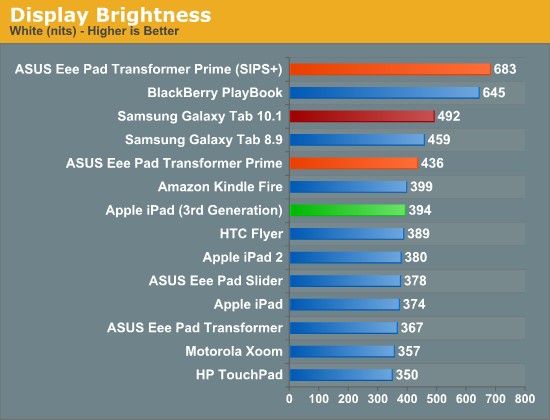
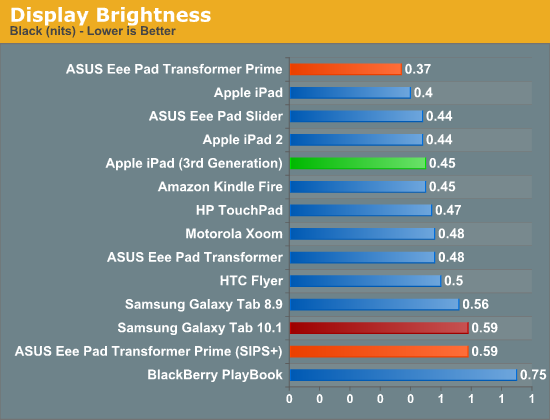
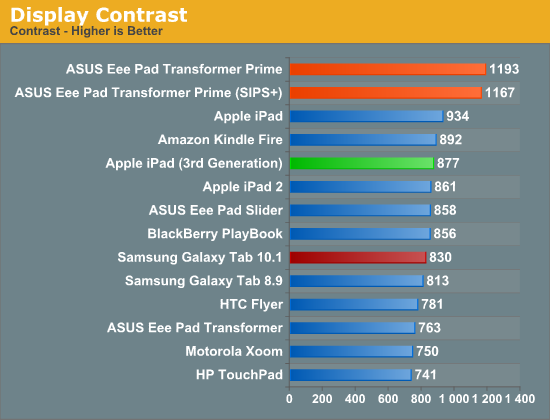
Apple is expected to have triple sourced panels for the new iPad, so you can expect to see variation in these results but for the most part you can expect the new iPad's display to perform similarly to the previous model.
Despite similar brightness and contrast to the previous model, the new iPad offers remarkably better color gamut and color reproduction than its predecessor. Relative to other tablets, the iPad's display is spectacular.
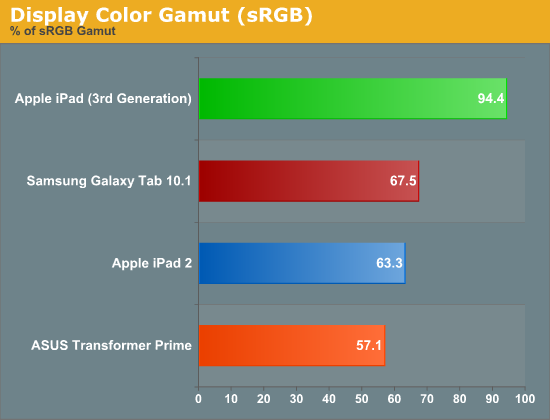
As we mentioned in our Retina Display analysis, Apple delivered on its claims of a 44% increase in color gamut. The new iPad offers nearly full coverage of the sRGB color space and over 60% of the Adobe RGB gamut:
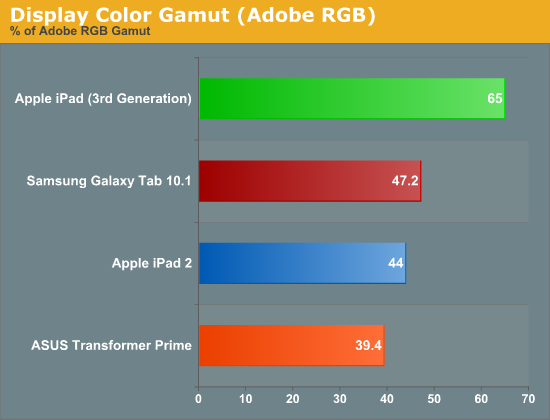
Below is the CIE diagram for the new panel with an sRGB reference plotted on the same chart so you can visualize the data another way:
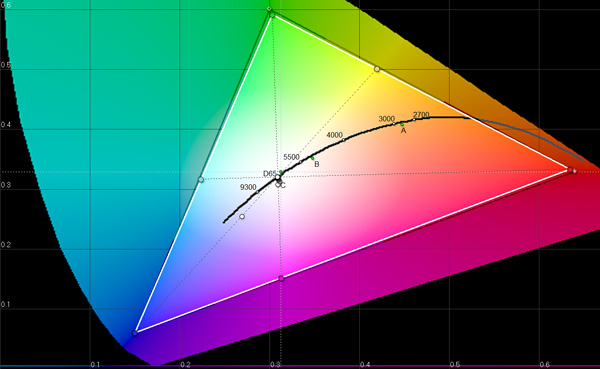
Color accuracy has improved tremendously if we look at delta E values for the primary and secondary colors:
Remember from our display reviews, lower delta E values indicate greater color accuracy. Values below 4 are typically considered good and you can see that the iPad 2 as well as the Transformer Prime both fell short in this department. With the new iPad Apple has clearly focused on color accuracy, which makes sense given it was used as the vehicle to introduce iPhoto for iOS.
Apple still has a lot of work ahead of itself to really put forth a professional quality display in a tablet, but for now the Retina Display is easily the best we've seen in a tablet and a tremendous step forward.
What's most absurd about the iPad's Retina Display is that you're able to get this resolution and panel quality in a $499 device. While we must be careful not to give Apple too much credit here as Samsung, Sharp and its other display partners clearly make the Retina Display, it's obvious that Apple has really been pushing its partners to develop solutions like this.
The biggest problem in the production of any commoditized component is the primary motivation for innovation is to lower cost. For years I argued with notebook PC makers to use higher quality LCD panels but no one was willing to commit to the quantities that would lower costs enough. I was also told that as soon as you put these notebooks on shelves at Best Buy, users wouldn't really care whether they were getting a high quality IPS display or not—all that mattered was the final price.
Apple, under the leadership of Steve Jobs, had a different mentality. Steve's pursuit was quality and experience, cost was a secondary concern. Through slow and steady iteration of this approach, Apple was able to build up a large enough customer base and revenue to be a significant force in the industry when it came to driving costs down. Apple can easily fill your fabs and eat all that you can produce, but you'll have to do whatever it wants to get the order.
Apple's behavior since it got rich has been to drive down the cost of higher quality components, LCDs being a perfect example. Unfortunately other companies don't benefit as much here as Apple tends to buy up all of the production of what it has pushed to create. That's one reason why, although ASUS was first to introduce a 1080p Transformer Pad, it won't launch until well after the new iPad. From what I've heard, the panel makers are all busy servicing Apple's needs—everyone else comes second.
Eventually the entire industry will benefit and all indications point to Apple doing something special for "pro" users in the notebook space next. As I've said previously, Apple has raised the bar with the iPad's Retina Display. The time for average display quality in a $500 tablet is over, the bar has been raised. It remains to be seen whether or not Apple will be able to maintain this quality across all suppliers of its Retina Display. On the iPhone Apple has been entirely too lax about maintaining consistency between suppliers. If it wants to be taken seriously in this space Apple needs to ensure a consistent experience across all of its component vendors.

















234 Comments
View All Comments
damianrobertjones - Thursday, March 29, 2012 - link
" It's got everything but the kitchen sink. "SD card reader?
USB port?
Ethernet port?
Removable battery?
Move files straight from the device to a pc without ANY software?
The list could go on.
darkcrayon - Thursday, March 29, 2012 - link
But there is n WIFI, optional LTE, Bluetooth 4, and a dock connector (which includes USB) to handle many similar functions.mr_ripley - Thursday, March 29, 2012 - link
oh, and also:a slot to plug in my punch cards and floppy discs
and it would be nice if it had disc drive so i could play my audio cds
maybe connect to dial up modems too
......
all because i could not move on to better ways of doing things. All of what you mention is either obsolete or redundant!!
dagamer34 - Friday, March 30, 2012 - link
I think you want a laptop....jihe - Thursday, March 29, 2012 - link
"I said I wanted to give it a shot at being a real productivity device"That is where you went wrong. Pads are toys and nothing more.
repoman27 - Thursday, March 29, 2012 - link
You might want to try running that last statement by a pilot, doctor or teacher. They're not terribly optimized for content creation at this point, but if you think that their value does not extend beyond mere entertainment, then you really haven't considered the possible use cases for these devices.mavere - Friday, March 30, 2012 - link
Don't forget lawyers.Lots and lots of trees have been saved since the iPad's introduction.
neoabraxas - Thursday, March 29, 2012 - link
I find it absolutely ridiculous that someone who does not appreciate the tablet form factor is offering their thoughts on the new iPad.Is there really nobody at Anandtech who genuinely enjoys tablets and can write a summary that is aimed more at tablet enthusiasts?
Bloggers like you do tend to write a lot on their devices. Most people don't. For them tablets are media consumption devices. I'm a programmer. When I get home the last thing I want to do with my computing equipment is type more. For me a tablet is ideal.
vol7ron - Thursday, March 29, 2012 - link
To be honest, the last thing I want to do on a tablet/smartphone is type. Unless, it's with the Transformer (or other like) keyboard, but even then it's still not what I want to use a tablet for.The main thing, for me, is reading.
MrCromulent - Thursday, March 29, 2012 - link
Great review! I was looking forward to reading it when I saw it posted yesterday evening.One point I'm missing from every review though: Has the touchscreen sensitivity / resolution changed in any way? The doubling of display resolution does not imply doubling of the touch input resolution, right? I love the iPad, but I always found it almost unusable for any kind of handwritten input (be it finger or stylus).